child restraint DODGE AVENGER 2008 Owners Manual
[x] Cancel search | Manufacturer: DODGE, Model Year: 2008, Model line: AVENGER, Model: DODGE AVENGER 2008Pages: 467, PDF Size: 7.16 MB
Page 12 of 467
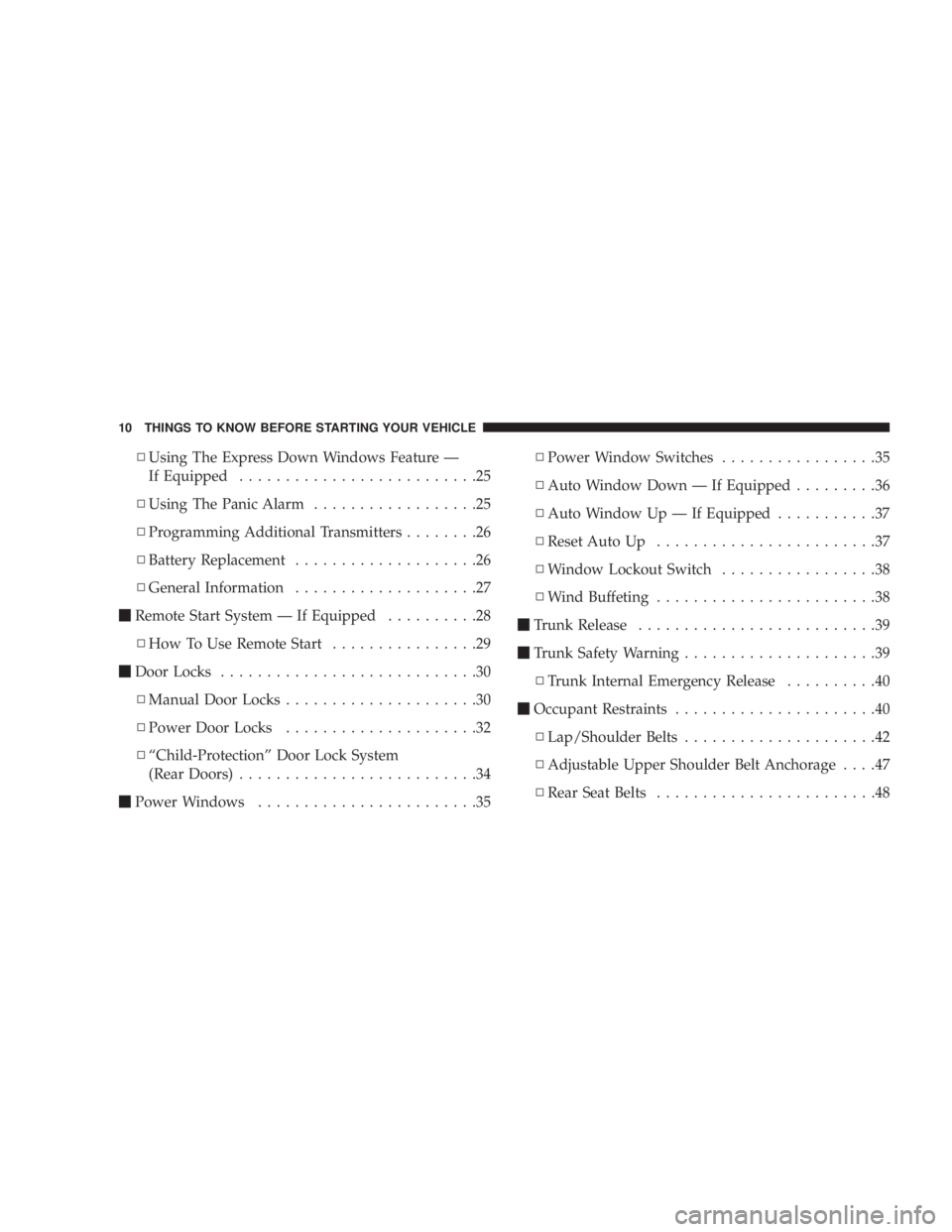
N Using The Express Down Windows Feature Ð
If Equipped ..........................25
N Using The Panic Alarm ..................25
N Programming Additional Transmitters ........26
N Battery Replacement ....................26
N General Information ....................27
m Remote Start System Ð If Equipped ..........28
N How To Use Remote Start ................29
m Door Locks ............................30
N Manual Door Locks .....................30
N Power Door Locks .....................32
N ªChild-Protectionº Door Lock System
(Rear Doors) ..........................34
m Power Windows ........................35 N Power Window Switches .................35
N Auto Window Down Ð If Equipped .........36
N Auto Window Up Ð If Equipped ...........37
N Reset Auto Up ........................37
N Window Lockout Switch .................38
N Wind Buffeting ........................38
m Trunk Release ..........................39
m Trunk Safety Warnin g.....................39
N Trunk Internal Emergency Release ..........40
m Occupant Restraints ......................40
N Lap/Shoulder Belts .....................42
N Adjustable Upper Shoulder Belt Anchorage ....47
N Rear Seat Belts ........................4810 THINGS TO KNOW BEFORE STARTING YOUR VEHICLE
Page 13 of 467
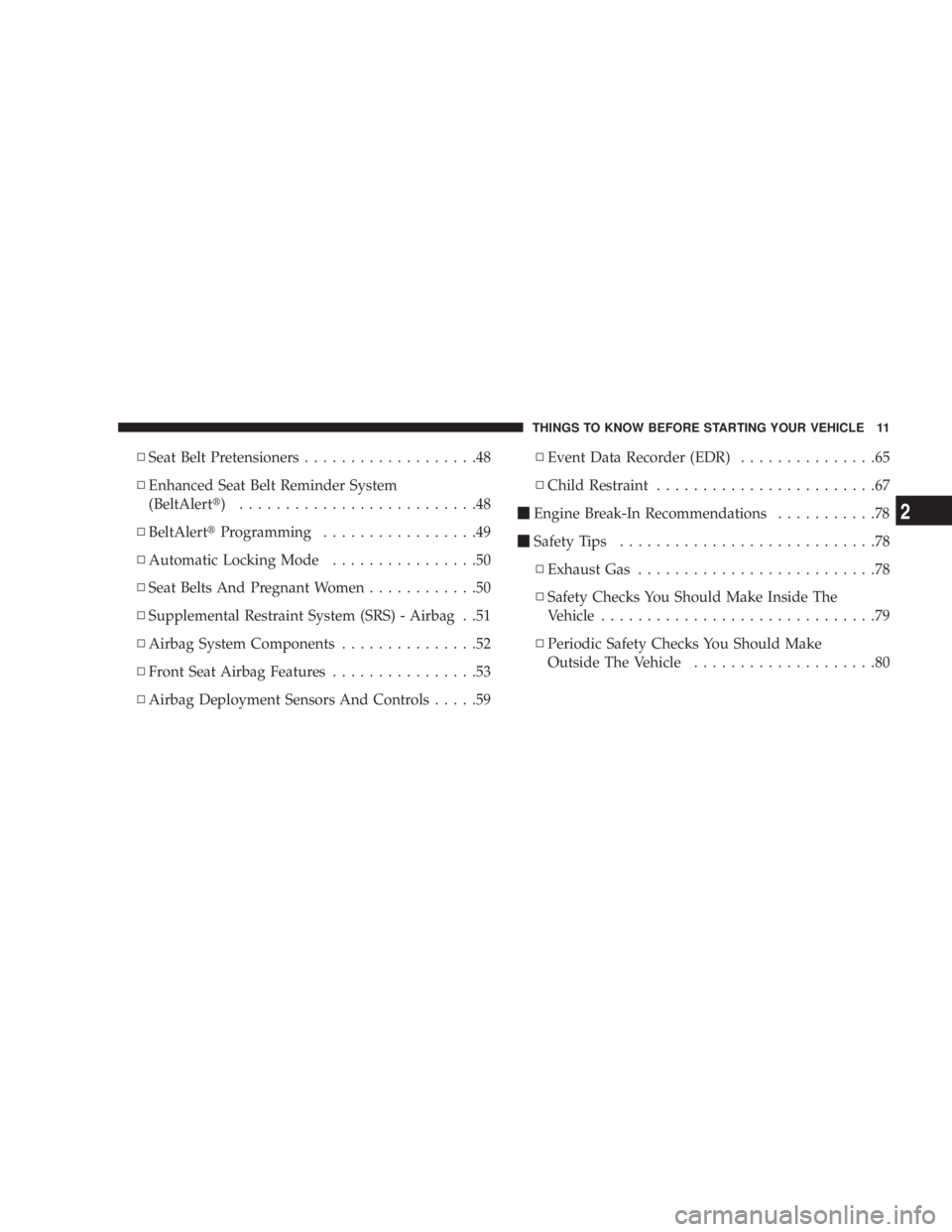
N Seat Belt Pretensioners ...................48
N Enhanced Seat Belt Reminder System
(BeltAlert t ) ..........................48
N BeltAlert t Programming .................49
N Automatic Locking Mode ................50
N Seat Belts And Pregnant Women ............50
N Supplemental Restraint System (SRS) - Airbag . .51
N Airbag System Components ...............52
N Front Seat Airbag Features ................53
N Airbag Deployment Sensors And Controls .....59 N Event Data Recorder (EDR) ...............65
N Child Restraint ........................67
m Engine Break-In Recommendations ...........78
m Safety Tips ............................78
N Exhaust Gas ..........................78
N Safety Checks You Should Make Inside The
Vehicle ..............................79
N Periodic Safety Checks You Should Make
Outside The Vehicle ....................80THINGS TO KNOW BEFORE STARTING YOUR VEHICLE 11
2
Page 43 of 467
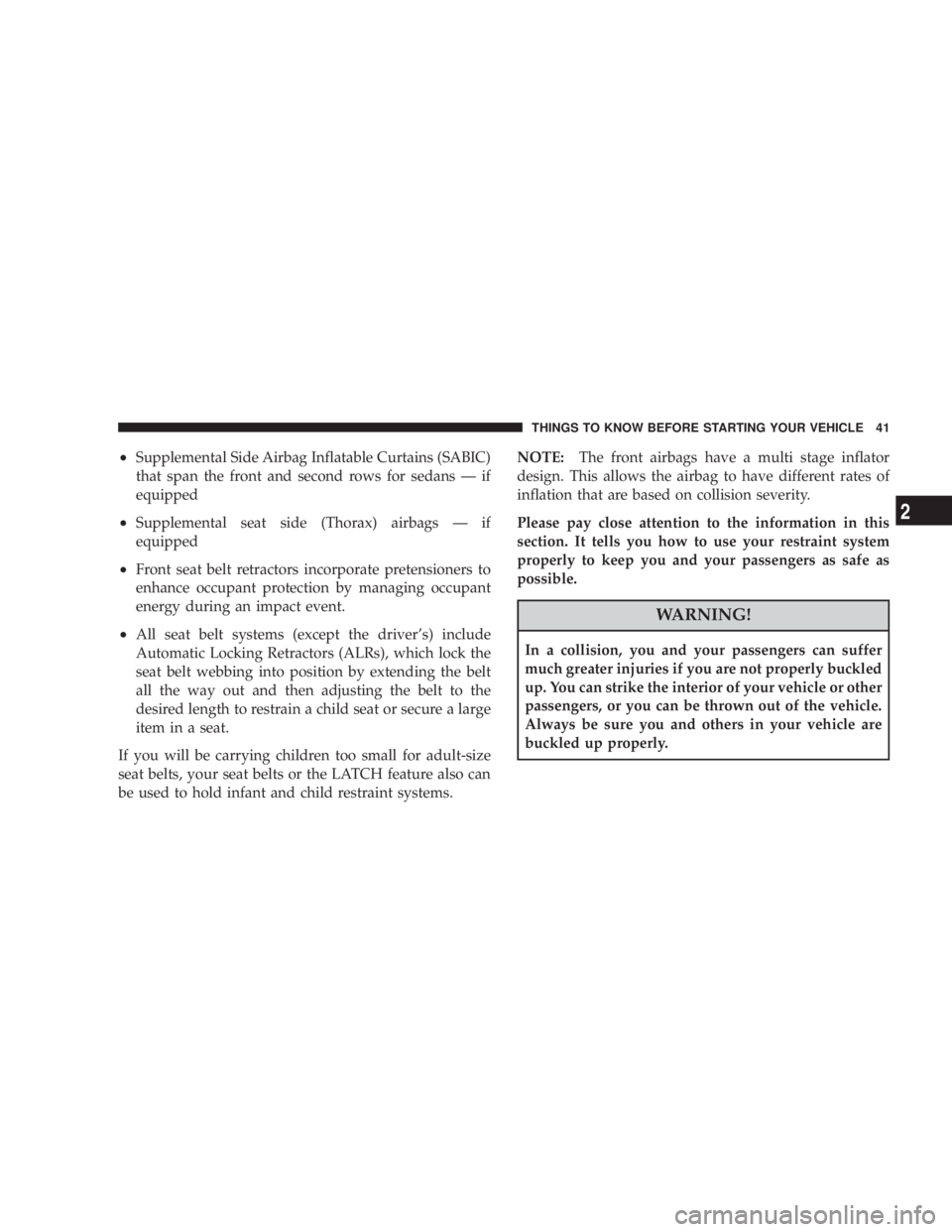
² Supplemental Side Airbag Inflatable Curtains (SABIC)
that span the front and second rows for sedans Ð if
equipped
² Supplemental seat side (Thorax) airbags Ð if
equipped
² Front seat belt retractors incorporate pretensioners to
enhance occupant protection by managing occupant
energy during an impact event.
² All seat belt systems (except the driver's) include
Automatic Locking Retractors (ALRs), which lock the
seat belt webbing into position by extending the belt
all the way out and then adjusting the belt to the
desired length to restrain a child seat or secure a large
item in a seat.
If you will be carrying children too small for adult-size
seat belts, your seat belts or the LATCH feature also can
be used to hold infant and child restraint systems. NOTE: The front airbags have a multi stage inflator
design. This allows the airbag to have different rates of
inflation that are based on collision severity.
Please pay close attention to the information in this
section. It tells you how to use your restraint system
properly to keep you and your passengers as safe as
possible.
WARNING!In a collision, you and your passengers can suffer
much greater injuries if you are not properly buckled
up. You can strike the interior of your vehicle or other
passengers, or you can be thrown out of the vehicle.
Always be sure you and others in your vehicle are
buckled up properly. THINGS TO KNOW BEFORE STARTING YOUR VEHICLE 41
2
Page 50 of 467
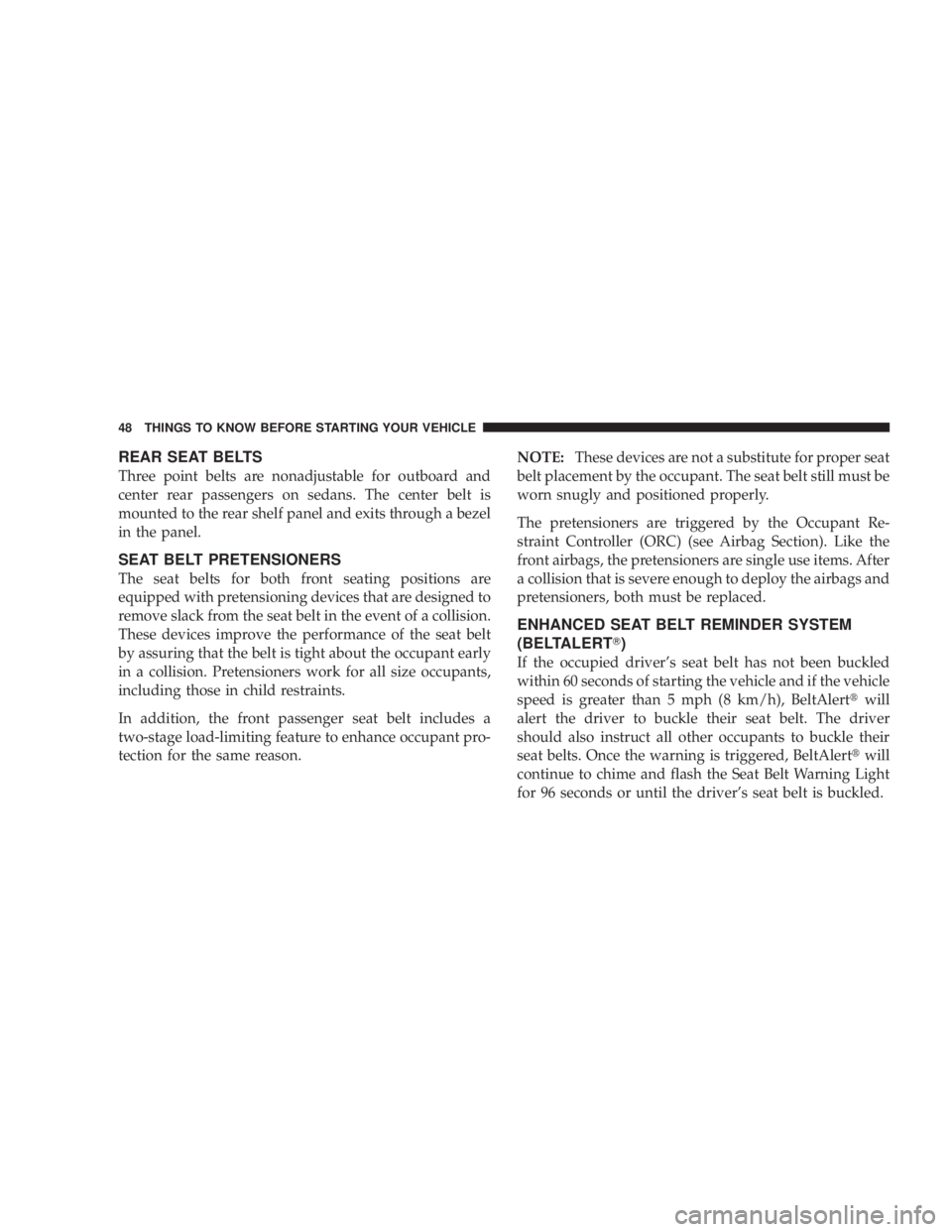
REAR SEAT BELTS
Three point belts are nonadjustable for outboard and
center rear passengers on sedans. The center belt is
mounted to the rear shelf panel and exits through a bezel
in the panel.
SEAT BELT PRETENSIONERS
The seat belts for both front seating positions are
equipped with pretensioning devices that are designed to
remove slack from the seat belt in the event of a collision.
These devices improve the performance of the seat belt
by assuring that the belt is tight about the occupant early
in a collision. Pretensioners work for all size occupants,
including those in child restraints.
In addition, the front passenger seat belt includes a
two-stage load-limiting feature to enhance occupant pro-
tection for the same reason. NOTE: These devices are not a substitute for proper seat
belt placement by the occupant. The seat belt still must be
worn snugly and positioned properly.
The pretensioners are triggered by the Occupant Re-
straint Controller (ORC) (see Airbag Section). Like the
front airbags, the pretensioners are single use items. After
a collision that is severe enough to deploy the airbags and
pretensioners, both must be replaced.
ENHANCED SEAT BELT REMINDER SYSTEM
(BELTALERT T )
If the occupied driver's seat belt has not been buckled
within 60 seconds of starting the vehicle and if the vehicle
speed is greater than 5 mph (8 km/h), BeltAlert t will
alert the driver to buckle their seat belt. The driver
should also instruct all other occupants to buckle their
seat belts. Once the warning is triggered, BeltAlert t will
continue to chime and flash the Seat Belt Warning Light
for 96 seconds or until the driver's seat belt is buckled.48 THINGS TO KNOW BEFORE STARTING YOUR VEHICLE
Page 59 of 467
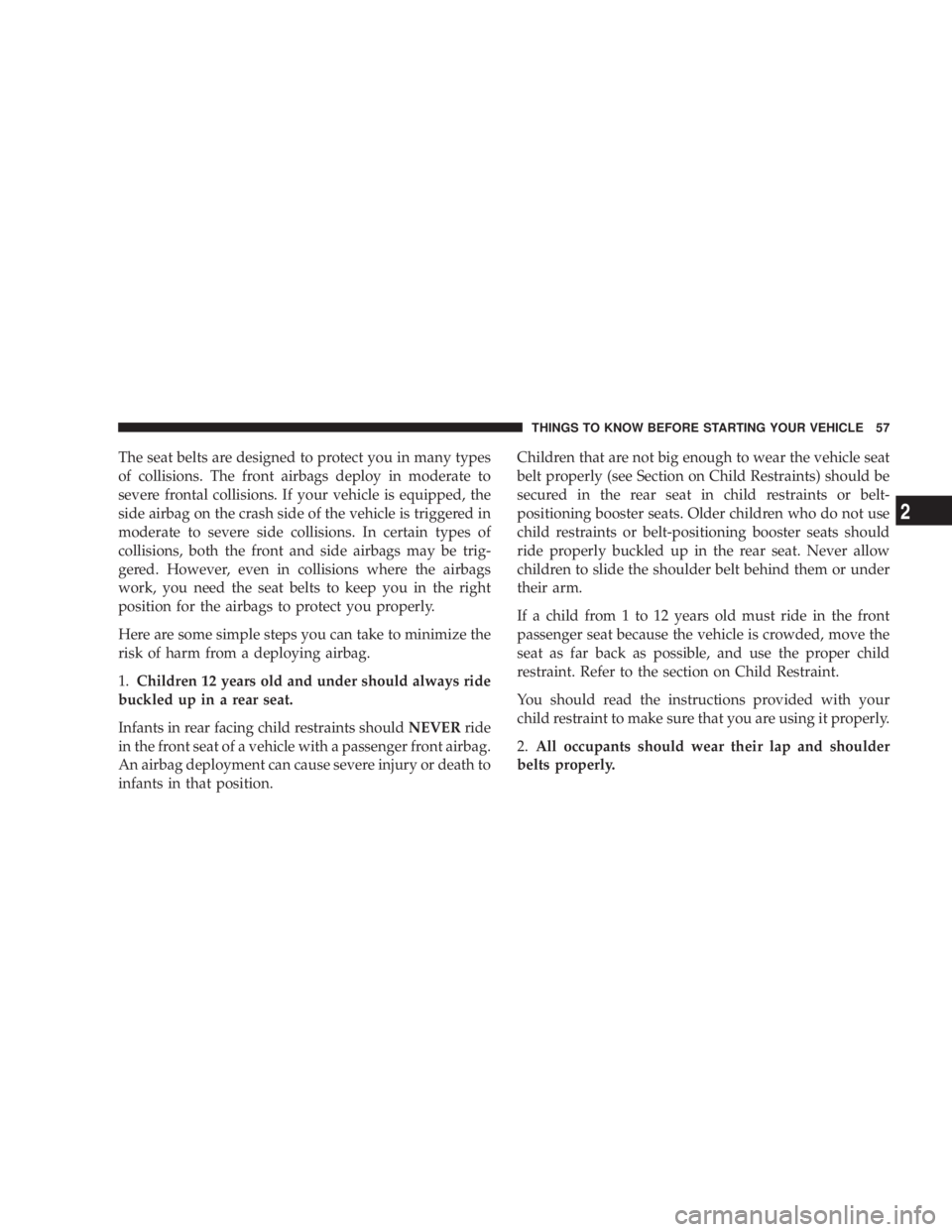
The seat belts are designed to protect you in many types
of collisions. The front airbags deploy in moderate to
severe frontal collisions. If your vehicle is equipped, the
side airbag on the crash side of the vehicle is triggered in
moderate to severe side collisions. In certain types of
collisions, both the front and side airbags may be trig-
gered. However, even in collisions where the airbags
work, you need the seat belts to keep you in the right
position for the airbags to protect you properly.
Here are some simple steps you can take to minimize the
risk of harm from a deploying airbag.
1. Children 12 years old and under should always ride
buckled up in a rear seat.
Infants in rear facing child restraints should NEVER ride
in the front seat of a vehicle with a passenger front airbag.
An airbag deployment can cause severe injury or death to
infants in that position. Children that are not big enough to wear the vehicle seat
belt properly (see Section on Child Restraints) should be
secured in the rear seat in child restraints or belt-
positioning booster seats. Older children who do not use
child restraints or belt-positioning booster seats should
ride properly buckled up in the rear seat. Never allow
children to slide the shoulder belt behind them or under
their arm.
If a child from 1 to 12 years old must ride in the front
passenger seat because the vehicle is crowded, move the
seat as far back as possible, and use the proper child
restraint. Refer to the section on Child Restraint.
You should read the instructions provided with your
child restraint to make sure that you are using it properly.
2. All occupants should wear their lap and shoulder
belts properly. THINGS TO KNOW BEFORE STARTING YOUR VEHICLE 57
2
Page 69 of 467
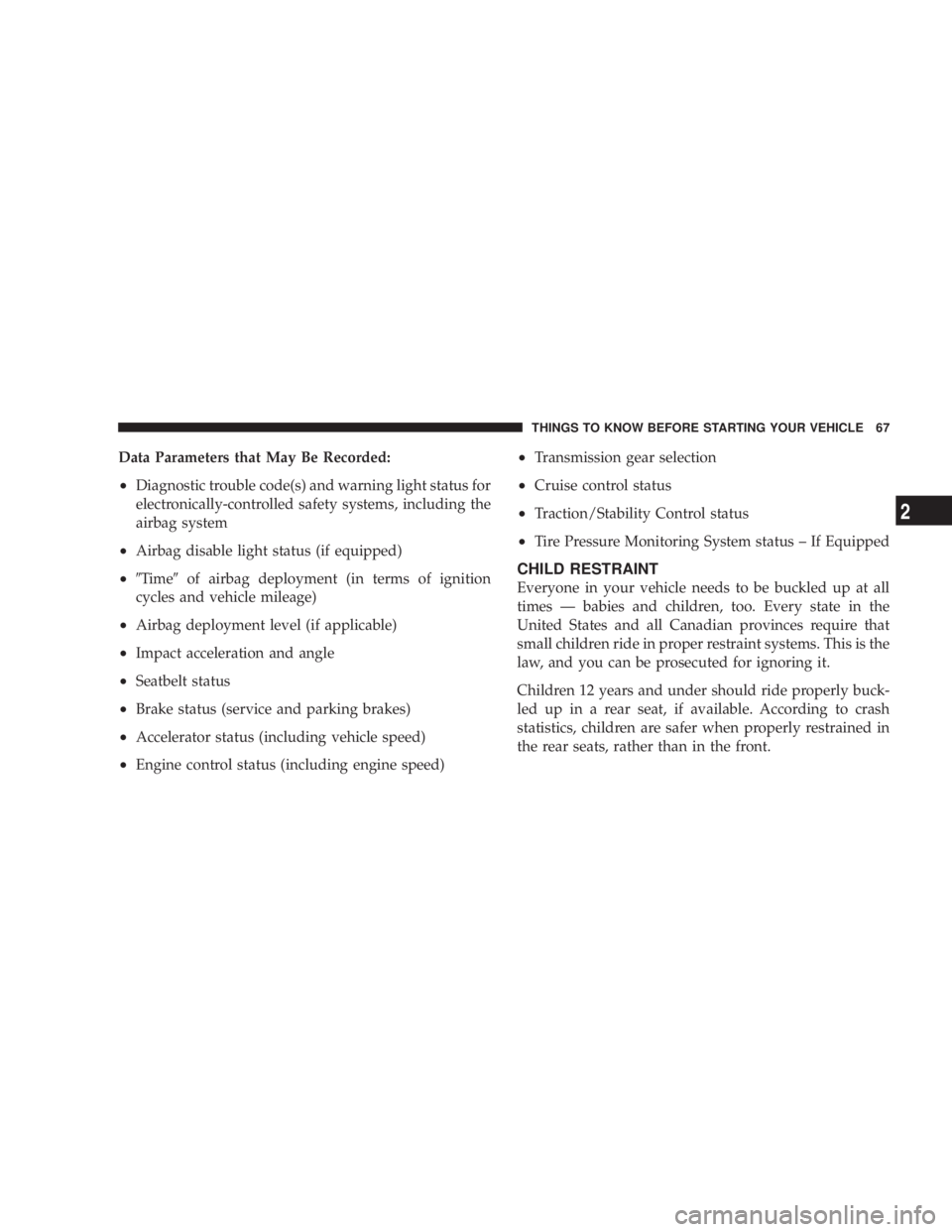
Data Parameters that May Be Recorded:
² Diagnostic trouble code(s) and warning light status for
electronically-controlled safety systems, including the
airbag system
² Airbag disable light status (if equipped)
² 9 Time 9 of airbag deployment (in terms of ignition
cycles and vehicle mileage)
² Airbag deployment level (if applicable)
² Impact acceleration and angle
² Seatbelt status
² Brake status (service and parking brakes)
² Accelerator status (including vehicle speed)
² Engine control status (including engine speed) ² Transmission gear selection
² Cruise control status
² Traction/Stability Control status
² Tire Pressure Monitoring System status ± If Equipped
CHILD RESTRAINT
Everyone in your vehicle needs to be buckled up at all
times Ð babies and children, too. Every state in the
United States and all Canadian provinces require that
small children ride in proper restraint systems. This is the
law, and you can be prosecuted for ignoring it.
Children 12 years and under should ride properly buck-
led up in a rear seat, if available. According to crash
statistics, children are safer when properly restrained in
the rear seats, rather than in the front. THINGS TO KNOW BEFORE STARTING YOUR VEHICLE 67
2
Page 70 of 467
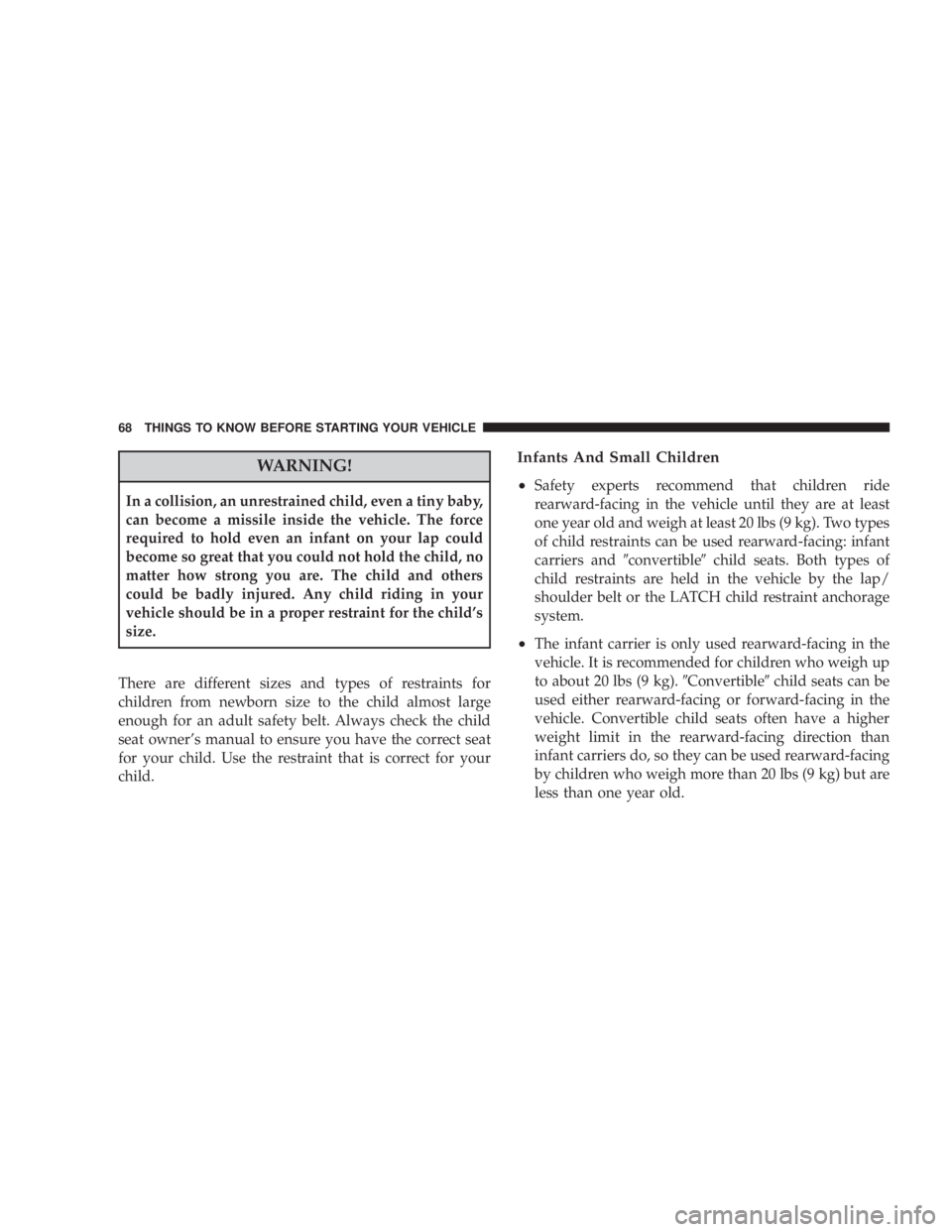
WARNING!In a collision, an unrestrained child, even a tiny baby,
can become a missile inside the vehicle. The force
required to hold even an infant on your lap could
become so great that you could not hold the child, no
matter how strong you are. The child and others
could be badly injured. Any child riding in your
vehicle should be in a proper restraint for the child's
size.
There are different sizes and types of restraints for
children from newborn size to the child almost large
enough for an adult safety belt. Always check the child
seat owner's manual to ensure you have the correct seat
for your child. Use the restraint that is correct for your
child. Infants And Small Children
² Safety experts recommend that children ride
rearward-facing in the vehicle until they are at least
one year old and weigh at least 20 lbs (9 kg). Two types
of child restraints can be used rearward-facing: infant
carriers and 9 convertible 9 child seats. Both types of
child restraints are held in the vehicle by the lap/
shoulder belt or the LATCH child restraint anchorage
system.
² The infant carrier is only used rearward-facing in the
vehicle. It is recommended for children who weigh up
to about 20 lbs (9 kg). 9 Convertible 9 child seats can be
used either rearward-facing or forward-facing in the
vehicle. Convertible child seats often have a higher
weight limit in the rearward-facing direction than
infant carriers do, so they can be used rearward-facing
by children who weigh more than 20 lbs (9 kg) but are
less than one year old.68 THINGS TO KNOW BEFORE STARTING YOUR VEHICLE
Page 71 of 467
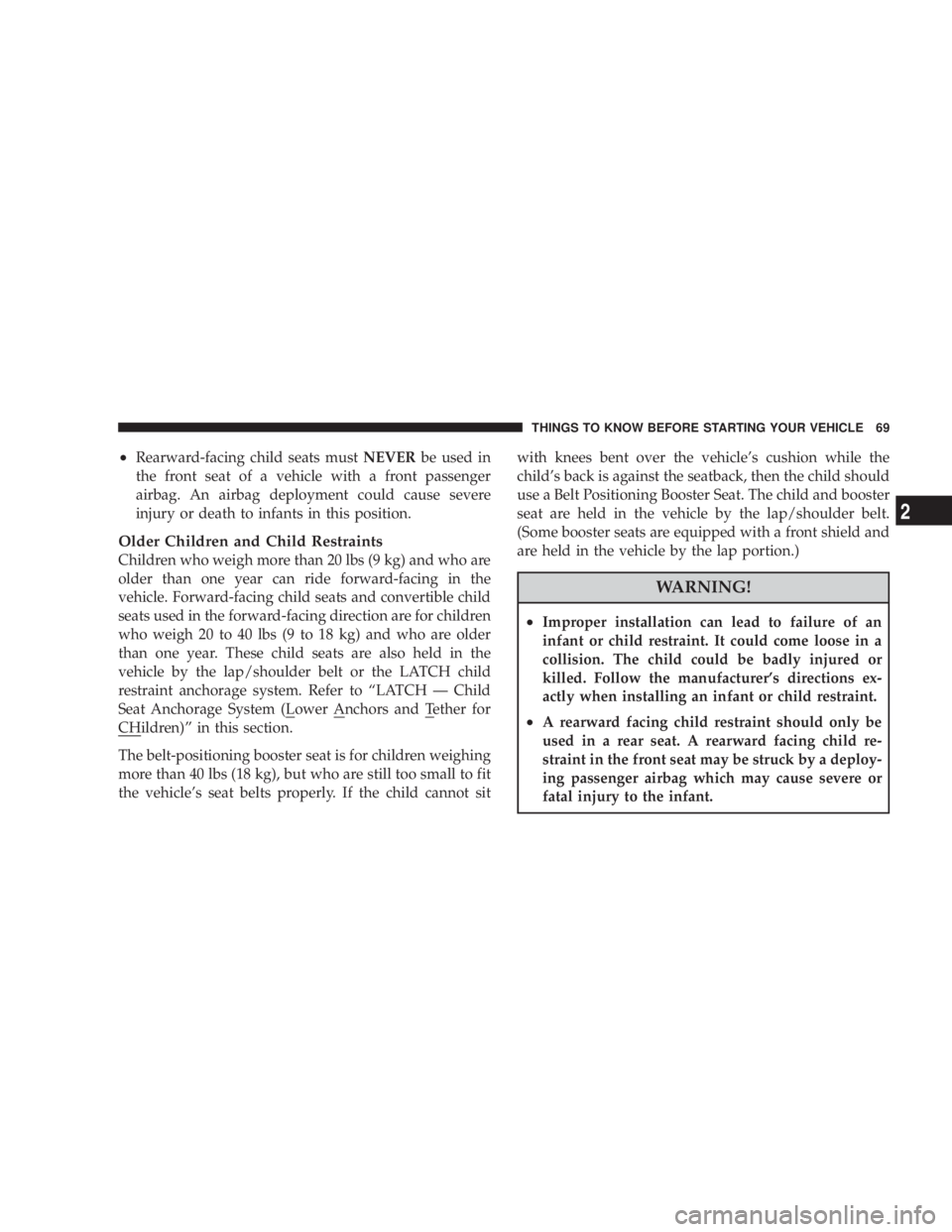
² Rearward-facing child seats must NEVER be used in
the front seat of a vehicle with a front passenger
airbag. An airbag deployment could cause severe
injury or death to infants in this position.
Older Children and Child Restraints
Children who weigh more than 20 lbs (9 kg) and who are
older than one year can ride forward-facing in the
vehicle. Forward-facing child seats and convertible child
seats used in the forward-facing direction are for children
who weigh 20 to 40 lbs (9 to 18 kg) and who are older
than one year. These child seats are also held in the
vehicle by the lap/shoulder belt or the LATCH child
restraint anchorage system. Refer to ªLATCH Ð Child
Seat Anchorage System (Lower Anchors and Tether for
CHildren)º in this section.
The belt-positioning booster seat is for children weighing
more than 40 lbs (18 kg), but who are still too small to fit
the vehicle's seat belts properly. If the child cannot sit with knees bent over the vehicle's cushion while the
child's back is against the seatback, then the child should
use a Belt Positioning Booster Seat. The child and booster
seat are held in the vehicle by the lap/shoulder belt.
(Some booster seats are equipped with a front shield and
are held in the vehicle by the lap portion.)
WARNING!² Improper installation can lead to failure of an
infant or child restraint. It could come loose in a
collision. The child could be badly injured or
killed. Follow the manufacturer's directions ex-
actly when installing an infant or child restraint.
² A rearward facing child restraint should only be
used in a rear seat. A rearward facing child re-
straint in the front seat may be struck by a deploy-
ing passenger airbag which may cause severe or
fatal injury to the infant. THINGS TO KNOW BEFORE STARTING YOUR VEHICLE 69
2
Page 72 of 467
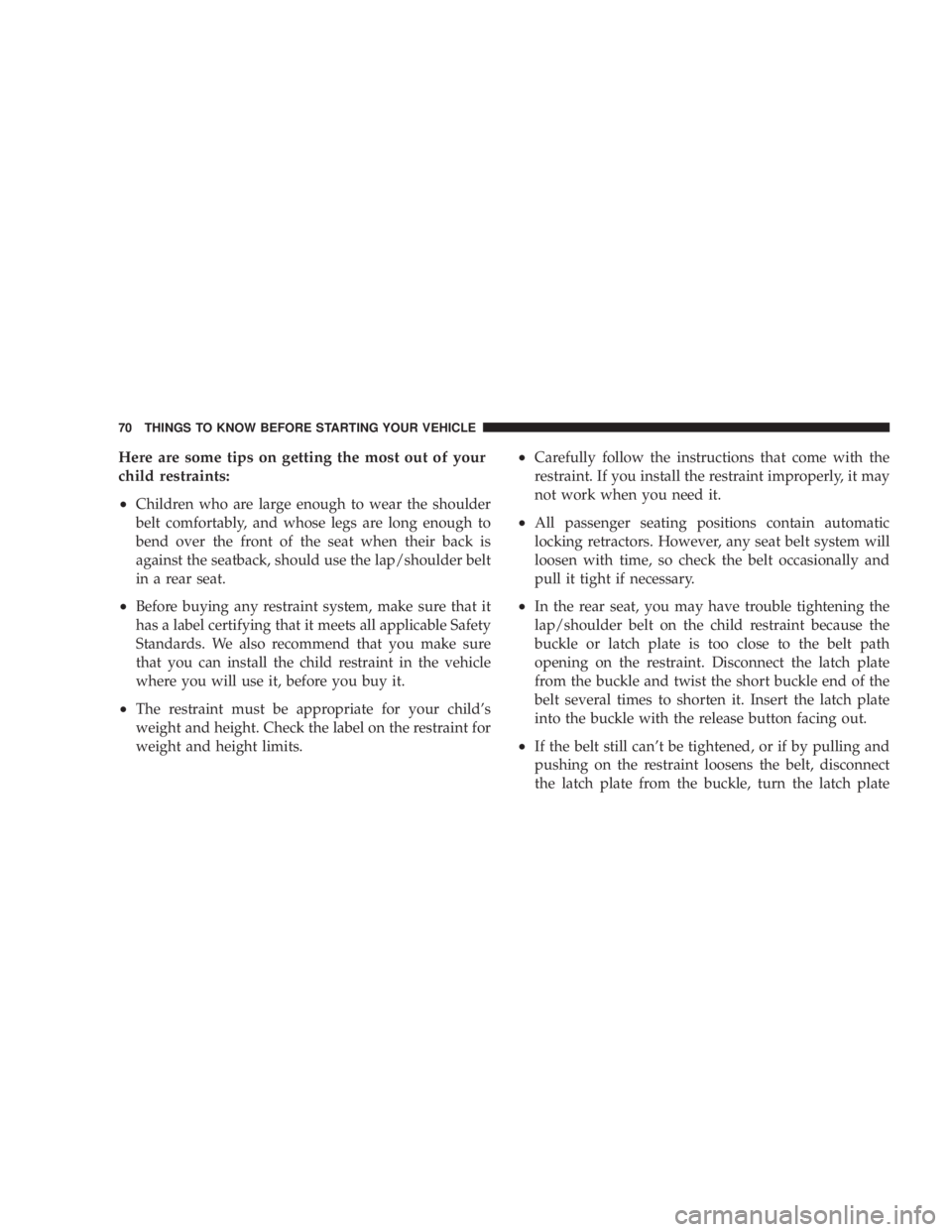
Here are some tips on getting the most out of your
child restraints:
² Children who are large enough to wear the shoulder
belt comfortably, and whose legs are long enough to
bend over the front of the seat when their back is
against the seatback, should use the lap/shoulder belt
in a rear seat.
² Before buying any restraint system, make sure that it
has a label certifying that it meets all applicable Safety
Standards. We also recommend that you make sure
that you can install the child restraint in the vehicle
where you will use it, before you buy it.
² The restraint must be appropriate for your child's
weight and height. Check the label on the restraint for
weight and height limits. ² Carefully follow the instructions that come with the
restraint. If you install the restraint improperly, it may
not work when you need it.
² All passenger seating positions contain automatic
locking retractors. However, any seat belt system will
loosen with time, so check the belt occasionally and
pull it tight if necessary.
² In the rear seat, you may have trouble tightening the
lap/shoulder belt on the child restraint because the
buckle or latch plate is too close to the belt path
opening on the restraint. Disconnect the latch plate
from the buckle and twist the short buckle end of the
belt several times to shorten it. Insert the latch plate
into the buckle with the release button facing out.
² If the belt still can't be tightened, or if by pulling and
pushing on the restraint loosens the belt, disconnect
the latch plate from the buckle, turn the latch plate70 THINGS TO KNOW BEFORE STARTING YOUR VEHICLE
Page 73 of 467
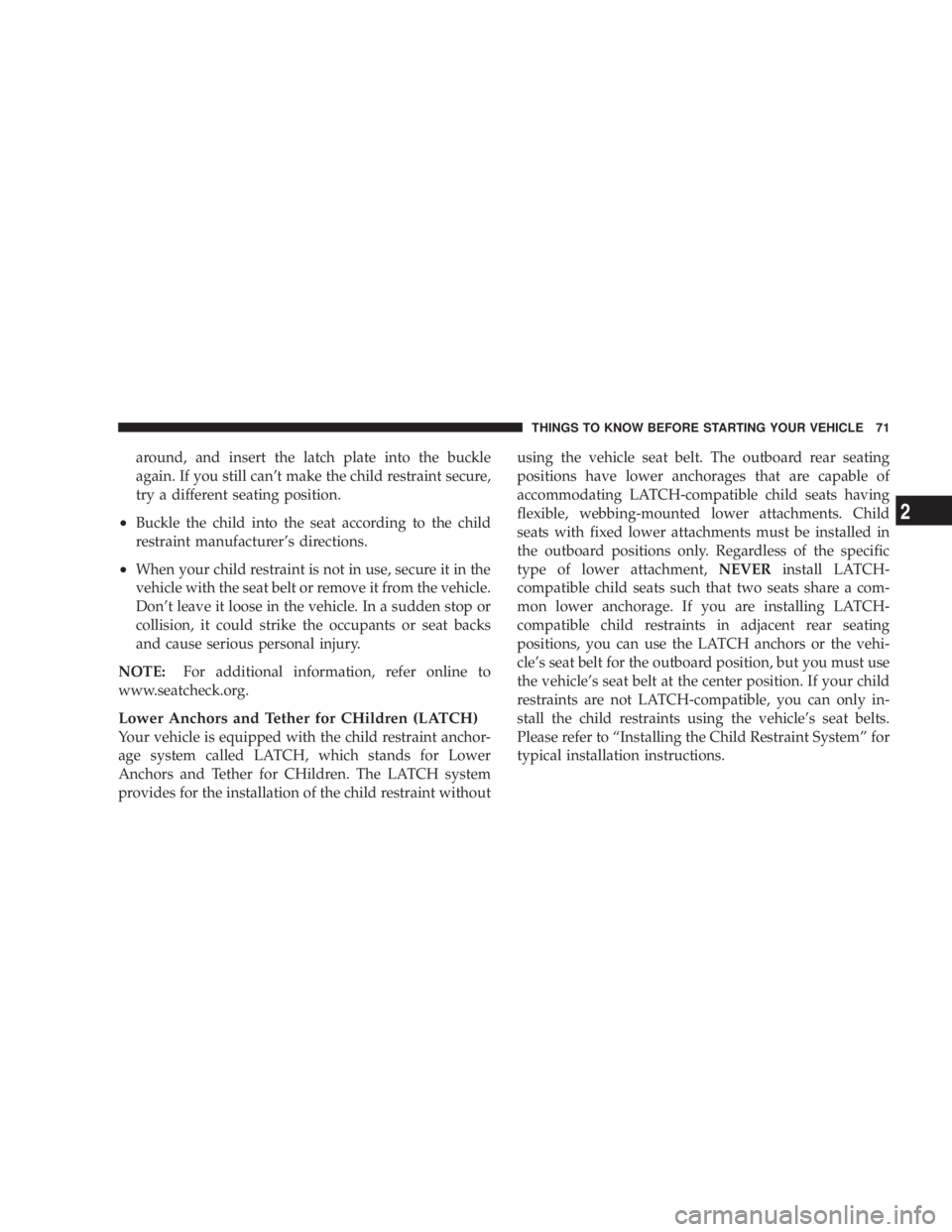
around, and insert the latch plate into the buckle
again. If you still can't make the child restraint secure,
try a different seating position.
² Buckle the child into the seat according to the child
restraint manufacturer's directions.
² When your child restraint is not in use, secure it in the
vehicle with the seat belt or remove it from the vehicle.
Don't leave it loose in the vehicle. In a sudden stop or
collision, it could strike the occupants or seat backs
and cause serious personal injury.
NOTE: For additional information, refer online to
www.seatcheck.org.
Lower Anchors and Tether for CHildren (LATCH)
Your vehicle is equipped with the child restraint anchor-
age system called LATCH, which stands for Lower
Anchors and Tether for CHildren. The LATCH system
provides for the installation of the child restraint without using the vehicle seat belt. The outboard rear seating
positions have lower anchorages that are capable of
accommodating LATCH-compatible child seats having
flexible, webbing-mounted lower attachments. Child
seats with fixed lower attachments must be installed in
the outboard positions only. Regardless of the specific
type of lower attachment, NEVER install LATCH-
compatible child seats such that two seats share a com-
mon lower anchorage. If you are installing LATCH-
compatible child restraints in adjacent rear seating
positions, you can use the LATCH anchors or the vehi-
cle's seat belt for the outboard position, but you must use
the vehicle's seat belt at the center position. If your child
restraints are not LATCH-compatible, you can only in-
stall the child restraints using the vehicle's seat belts.
Please refer to ªInstalling the Child Restraint Systemº for
typical installation instructions. THINGS TO KNOW BEFORE STARTING YOUR VEHICLE 71
2